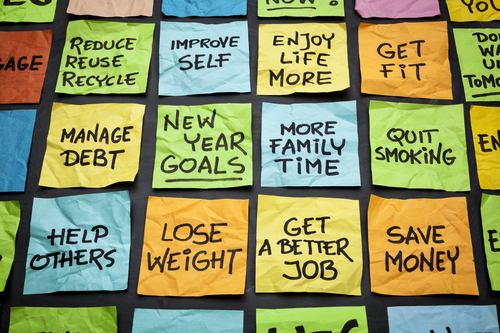by Veronica Vaiti, LCSW-R
 Here we are again at this juncture in time – the start of a brand new year. And what this time usually brings with it is the pressure to create a resolution or two or more for how we will be different, better or a more improved version of ourselves in the New Year. So we may hear or make declarations such as, “I’m done with cigarettes…I will go to the gym every day before work…I promise not to be so judgmental…I will volunteer at the homeless shelter every Sunday…” and the list can go on from there.
Here we are again at this juncture in time – the start of a brand new year. And what this time usually brings with it is the pressure to create a resolution or two or more for how we will be different, better or a more improved version of ourselves in the New Year. So we may hear or make declarations such as, “I’m done with cigarettes…I will go to the gym every day before work…I promise not to be so judgmental…I will volunteer at the homeless shelter every Sunday…” and the list can go on from there.
And then what happens….the New Year begins and we find ourselves trying hard to stick with our endeavor to be improved for a bit of time until it either feels too hard to continue or being the way we were just feels more comfortable even if it’s no good for us or to those we are surrounded by. Why is that?
I think the struggle with sticking to New Year’s resolutions is due to three main reasons:
1 – our attitude – the initial approach and our thinking about the “change” is problematic
2 – our sense of self-competency – setting unrealistic or idealistic goals
3 – our level of personal awareness – lack of being fully honest with oneself
Let’s look at the #1. Because a resolution by definition means a fixed decision to do or not do something, this sets an attitudinal tone of rigidity about making the change and doesn’t allow much room for the ebb and flow that making changes usually requires. Meaning for many people change does not occur in a direct linear fashion but is rather a circuitous back and forth process. And although for some people, rigidity in decision making is the only thing that will work, for many it does not and can backfire.
Instead, I suggest thinking in terms of setting a new Intention for the New Year which can allow for a more fluid approach. An intention is defined as an aim or a plan and so it provides a direction to follow rather than a fixed idea for how one should be. Which leads to #2 – the type of goals one chooses to set and the related sense of self-competency in achieving them.
Sometimes the goals we set for ourselves can be outside of what is realistic for ourselves which erodes rather than enhances our sense of self-competency. For example, an overweight father of young triplets who works 2 sedentary jobs to make ends meet strives to drop weight and live a healthier lifestyle this year. So he declared he would wake up every day at 4:30am to get to the gym before heading out to his first job. This lasted for all of 2 days. The circumstances of his life just did not support this goal. He then felt even worse about himself for not sticking with his resolution.
This father had the intention part of the equation right but the goal setting was all wrong. Another way to go about living healthier for him may involve looking at his eating habits to see where he could make healthier choices as well as adding shorter bursts of movement and exercise throughout his day, such as taking the stairs instead of the elevator and take momentary work breaks to stretch and do isolated strength building such as push-ups.
Going about things in a more moderate fashion rather than an extreme, do or die manner can allow for change to occur on a gradual basis which is not only easier to adjust to but helps make change more realizable. And because small achievements tallied up along the way provides more momentum to keep going and helps the change last longer!
But what if neither the fixed and extreme nor the moderate and gradual approach works and only obstacles show up instead of change? Here’s where #3 comes in – Honesty, with oneself. How honest are you being about your reasons for wanting this change in the first place? Have you examined what you truly believe about yourself and your ability to make a change in your life? What do you feel about how your life is going for you now and how willing are you to alter that? To get started on this process to setting a New Year’s Intention and charting a course for change that can prove more productive and successful, try the following steps:
- Begin by taking a realistic inventory of your current life. Get out the old school pad of paper and pen, not an electrical device. The reason for this is that the act of actually writing out your thoughts on paper can feel more personal and help you feel more connected to what you are writing about.
- Make a list of all you all you have accomplished this past year.
- Make another list of what you wish to bring forth from last year into the new one and what you wish to leave behind.
- And then make a list of what you hope to create in this New Year.
- Then finally, set your intention for how you would like to go about bringing these changes into your life, what that may entail and what it might look like.
Here’s a little fact for you – everything and everyone changes, whether we like it or not and whether we take time to fully notice. Change in life is a constant and how it comes about often times is the result of many different factors and variables, some of which is up to us and many which are not. Yet, pursuing a wanted change with pure intention and a clear path can lead to a greater chance of making it a reality.



